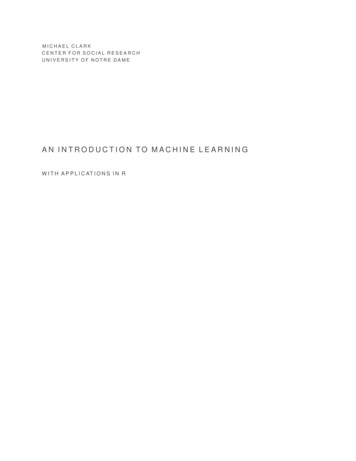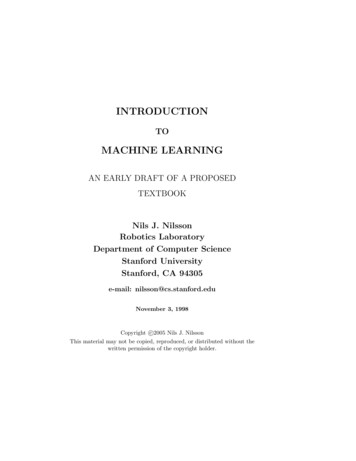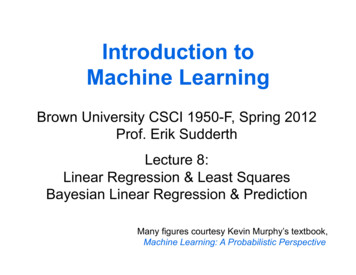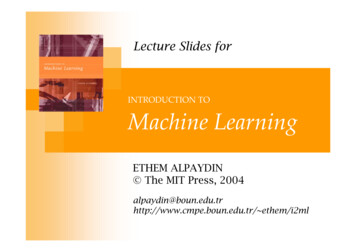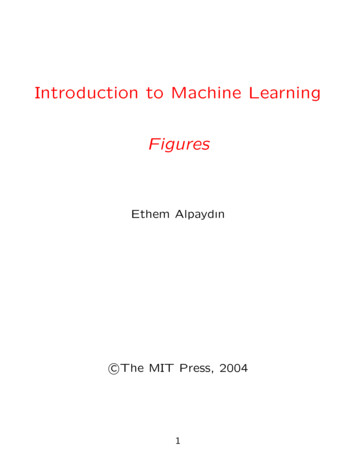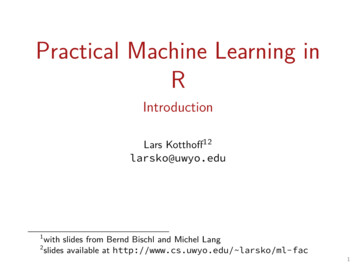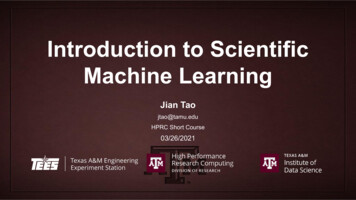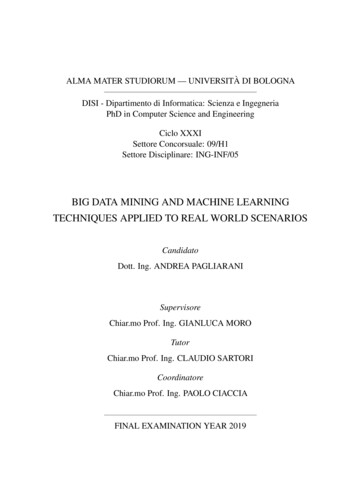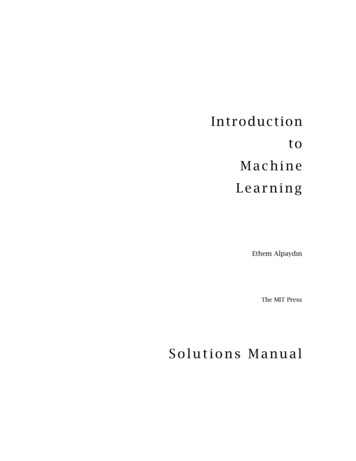
Transcription
IntroductiontoMachineLearningEthem AlpaydınThe MIT PressSolutions Manual
Please email remarks, suggestions, corrections toalpaydin@boun.edu.trVersion 1 Printed on January 10, 2007
1Introduction1. Imagine you have two possibilities: You can fax a document, that is,send the image, or you can use an optical character reader (OCR) andsend the text file. Discuss the advantage and disadvantages of the twoapproaches in a comparative manner. When would one be preferableover the other?The text file typically is shorter than the image file but a faxed document can also contain diagrams, pictures, etc. After using an OCR, welose properties such as font, size, etc (unless we also recognize andtransmit such information) or the personal touch if it is handwrittentext. OCR may not be perfect, and for ambigious cases, OCR shouldidentify those image blocks and transmit them as they are. A fax machine is cheaper and easier to find than a computer with scanner andOCR software.OCR is good if we have high volume, good quality documents; for documents of few pages with small amount of text, it is better to transmitthe image.2. Let us say we are building an OCR and for each character, we storethe bitmap of that character as a template that we match with the readcharacter pixel by pixel. Explain when such a system would fail. Whyare barcode readers still used?Such a system allows only one template per character and cannot distinguish characters from multiple fonts, for example. There are standardized fonts such as OCR-A and OCR-B, the fonts you typically seein vouchers and banking slips, which are used with OCR software, andyou may have already noticed how the characters in these fonts havebeen slightly changed to minimize the similarities between them. Bar-
21Introductioncode readers are still used because reading barcodes is still a better(cheaper, more reliable, more available) technology than reading characters.3. Assume we are given the task to build a system that can distinguishjunk e-mail. What is in a junk e-mail that lets us know that it is junk?How can the computer detect junk through a syntactic analysis? Whatwould you like the computer to do if it detects a junk e-mail—deleteit automatically, move it to a different file, or just highlight it on thescreen?Typically, spam filters check for the existence/absence of words andsymbols. Words such as “opportunity”, ”viagra”, ”dollars” as well ascharacters such as ’ ’, ’!’ increase the probability that the email isspam. These probabilities are learned from a training set of examplepast emails that the user has previously marked as spam (One veryfrequently used method for spam filtering is the naive Bayes’ classifierwhich we discuss in Section 5.7).The spam filters do not work with 100 percent reliability and frequently make errors in classification. If a junk mail is not filteredand showed to the user, this is not good, but it is not as bad as filtering a good mail as spam. Therefore, mail messages that the systemconsiders as spam should not be automatically deleted but kept asideso that the user can see them if he/she wants to, especially in theearly stages of using the spam filter when the system has not yet beentrained sufficiently.Note that filtering spam will probably never be solved completely asthe spammers keep finding novel ways to outdo the filters: They usedigit ‘0’ instead of the letter ’O’, digit ‘1’ instead of letter ‘l’ to passthe word tests, add pieces of texts from regular messages for the mailto be considered not spam, or send it as image not as text (and latelydistort the image in small random amounts to that it is not always thesame image). Still, spam filtering is probably one of the best application areas of machine learning where learning systems can adapt tochanges in the ways spam messages are generated.4. Let us say you are given the task of building an automated taxi. Definethe constraints. What are the inputs? What is the output? How can youcommunicate with the passenger? Do you need to communicate withthe other automated taxis, that is, do you need a “language”?
3An automated taxi should be able to pick a passenger and drive him/herto a destination. It should have some positioning system (GPS/GIS) andshould have other sensors (cameras) to be able to sense cars, pedestrians, obstacles etc on the road. The output should be the sequenceof actions to reach the destination in the smallest time with the minimum inconvenience to the passenger. The automated taxi needs tocommunicate with the passenger to receive commands and may alsoneed to interact with other automated taxis to exhange informationabout road traffic or scheduling, load balancing, etc.5. In basket analysis, we want to find the dependence between two itemsX and Y . Given a database of customer transactions, how can you findthese dependencies? How would you generalize this to more than twoitems?This is discussed in Section 3.9.6. How can you predict the next command to be typed by the user? Orthe next page to be downloaded over the Web? When would such aprediction be useful? When would it be annoying?These are also other applications of basket analysis. The result ofany statistical estimation has the risk of being wrong. That is, suchdependencies should always be taken as an advice which the user canthen adopt or refuse. Assuming them to be true and taking automaticaction accordingly would be annoying.
2Supervised Learning1. Write the computer program that finds S and G from a given trainingset.The Matlab code given in ex2 1.m does not consider multiple possiblegeneralizations of S or specializations of G and therefore may notwork for small datasets. An example run is given in figure igure 2.1 ‘ ’/’o’ are the positive and negative examples. C, S and G are theactual concept, the most specific hypothesis and the most general hypothesisrespectively.
52. Imagine you are given the training instances one at a time, instead ofall at once. How can you incrementally adjust S and G in such a case?(Hint: See the candidate elimination algorithm in Mitchell 1997.)The candidate elimination algoritm proposed by Mitchell starts withS as the null set and G as containing the whole input space. At eachinstance x, S and G are updated as follows (Mitchell, 1997; p. 33): If x is a positive example, remove any g G that covers x andexpand any s S that does not cover xIf x is a negative example, remove any s S that covers x andrestrict any g G that does cover xx2: Engine powerThe important point is that when we are restricting a g G (specialization) or expanding a s S (generalization), there may be more thanone way of doing it, and this creates multiple hypotheses in S or G. Forexample, in figure 2.2, if we see a negative example at (20000, 2000)after two positive examples G ( x , y ) splits intwo: G ( x 20000, y ), ( x , y 2000). These are two different ways of specializing G so that it doesnot include any positive example.G21,800SG11,6001,4001,20010,00015,000 20,000x1: PriceFigure 2.2 There are two specializations of G.
62 Supervised Learning3. Why is it better to use the average of S and G as the final hypothesis?If there is noise, instances may be slightly changed; in such a case,using halfway between S and G will make the hypothesis robust tosuch small perturbations.4. Let us say our hypothesis class is a circle instead of a rectangle. Whatare the parameters? How can the parameters of a circle hypothesis becalculated in such a case? What if it is an ellipse? Why does it makemore sense to use an ellipse instead of a circle? How can you generalizeyour code to K 2 classes?x2: Engine powerIn the case of a circle, the parameters are the center and the radius (seefigure 2.3). We then need to find the tightest circle that includes all thepositive examples as S and G will be the largest circle that includes allthe positive examples and no negative example:c2Cccrc1x1: PriceFigure 2.3 Hypothesis class is a circle with two parameters, the coordinates ofits center and its radius.It makes more sense to use an ellipse because the two axes need nothave the same scale and an ellipse has two separate parameters forthe widths in the two axes rather than a single radius.When there are K 2 classes, we need a separate circle/ellipse foreach class. For each class Ci , there will be one hypothesis which takes
7all elements of Ci as positive examples and instances of all Cj , j 6 i asnegative examples.5. Imagine our hypothesis is not one rectangle but a union of two (or m 1) rectangles. What is the advantage of such a hypothesis class? Showthat any class can be represented by such a hypothesis class with largeenough m.x2: Engine powerIn the case when there is a single rectangle, all the positive instancesshould form one single group; by increasing the number of rectangles,we get flexibility. With two rectangles for example (see figure 2.4),the positive instances can form two, possibly disjoint clusters in theinput space. Note that each rectangle corresponds to a conjunction onthe two input attributes and having multiple rectangles, correspondsto a disjunction. Any logical formula can be written as a disjunctionof conjunctions. In the worst case (m N), we can have a separaterectangle for each positive instance.h1Ch2x1: PriceFigure 2.4Hypothesis class is a union of two rectangles.6. If we have a supervisor who can provide us with the label for any x,where should we choose x to learn with fewer queries?The region of ambiguity is between S and G. It would be best to begiven queries there so that we can make this region of doubt smaller.If a given instance there turns out to be positive, this means we can
82 Supervised Learningmake S larger up to that instance; if it is negative, this means we canshrink G up until there.7. In equation 2.12, we summed up the squares of the differences betweenthe actual value and the estimated value. This error function is the onemost frequently used, but it is one of several possible error functions.Because it sums up the squares of the differences, it is not robust tooutliers. What would be a better error function to implement robustregression?As we see in Chapter 4, the squared error corresponds to assumingthat there is Gaussian noise. If the noise comes from a distributionwith long tails, then summing up squared differences cause a few, faraway points, i.e., outliers, to corrupt the fitted line.To decrease the effect of outliers, we can sum up the absolute value ofdifferences instead of squaring them:E(g X) N1 X t r g(xt ) N t 1but note that we lose from differentiability. Support vector regression which we discuss in Chapter 10 uses an error function (see equation 10.61 and figure 10.13) which uses absolute difference and alsohas a term that neglects the error due to very small differences.8. Derive equation 2.16.We take the derivative of the sum of squared errors with respect to thetwo parameters, set them equal to 0 and solve these two equations intwo unknowns:E(w1 , w0 X) E w0Xrttw0 E w1 N 21 X tr (w1 xt w0 )N i 1X r t (w1 xt w0 ) 0tw1XtXtr t /N w1X txt Nw0Xtxt /N r w1 x r t (w1 xt w0 ) xt 0
9Xr t xttXt tr xtXr xXr t xtt tttw1 w1Xtw1Xt w1 w1 PP(xt )2 w0t 2Xxtt(x ) (r w1 x)XtXtt 2(x ) xXtx t Xxtt rXxtt(xt )2 xNx r Nxt tt r x xr Nt (xt )2 Nx29. Assume our hypothesis class is the set of lines, and we use a line toseparate the positive and negative examples, instead of bounding thepositive examples as in a rectangle, leaving the negatives outside (seefigure 2.10). Show that the VC dimension of a line is 3.x2x2As we see in figure 2.5 below, for all possible labeling of three points,there exist a line to separate positive and negative examples. With fourpoints, no matter how we place these four points in two dimensions,there is at least one labeling where we cannot draw a line such that onone side lie all the positives and on the other lie all the negatives.x1All possible labelings of three points can be separatedusing a line.x1These four points cannot be separated using a line.Figure 2.5 With a line, we can shatter three points but not four.10. Show that the VC dimension of the triangle hypothesis class is 7 in two
102 Supervised Learningdimensions. (Hint: For best separation, it is best to place the seven pointsequidistant on a circle.)x2x2As we can see in figure 2.6, for all possible labeling of seven points,we can draw a triangle to separate the positive and negative examples.We cannot do the same when there are eight points.x1These seven points can be separated using atriangle no matter how they are labeled.x1These eight points with this labeling cannot beseparated using a triangle.Figure 2.6 A triangle can shatter seven points but not eight.
3Bayesian Decision Theory1. In a two-class problem, the likelihood ratio isp(x C1 )p(x C2 )Write the discriminant function in terms of the likelihood ratio.We can define a discriminant function as(C1P (C1 x)g(x) and chooseC2P (C2 x)if g(x) 1otherwiseWe can write the discriminant as the product of the likelihood ratioand the ratio of priors:g(x) p(x C1 ) P (C1 )p(x C2 ) P (C2 )If the priors are equal, the discriminant is the likelihood ratio (see alsothe next exercise).2. In a two-class problem, the log odds is defined aslogP (C1 x)P (C2 x)Write the discriminant function in terms of the log odds.We define a discriminant function asP (C1 x)g(x) logand chooseP (C2 x)(C1C2if g(x) 0otherwise
123 Bayesian Decision TheoryLog odds is the sum of log likelihood ratio and log of prior ratio:g(x) logp(x C1 )P (C1 ) logp(x C2 )P (C2 )If the priors are equal, the discriminant is the log likelihood ratio.3. In a two-class, two-action problem, if the loss function is λ 11 λ22 0,λ12 10, and λ21 1, write the optimal decision rule.We calculate th
8 2 Supervised Learning make Slarger up to that instance; if it is negative, this means we can shrink Gup until there. 7. In equation 2.12, we summed up the squares of the di erences between the actual value and the estimated value. This error function is the one most frequently used, but it is one of several possible error functions.

